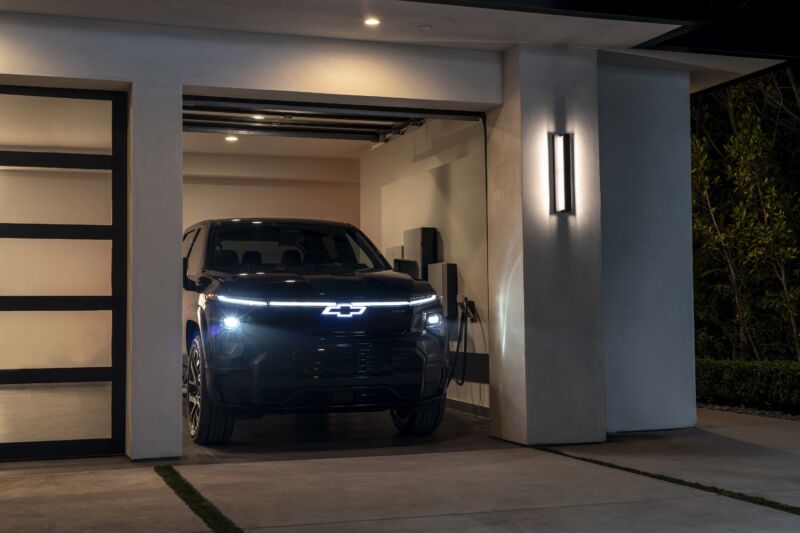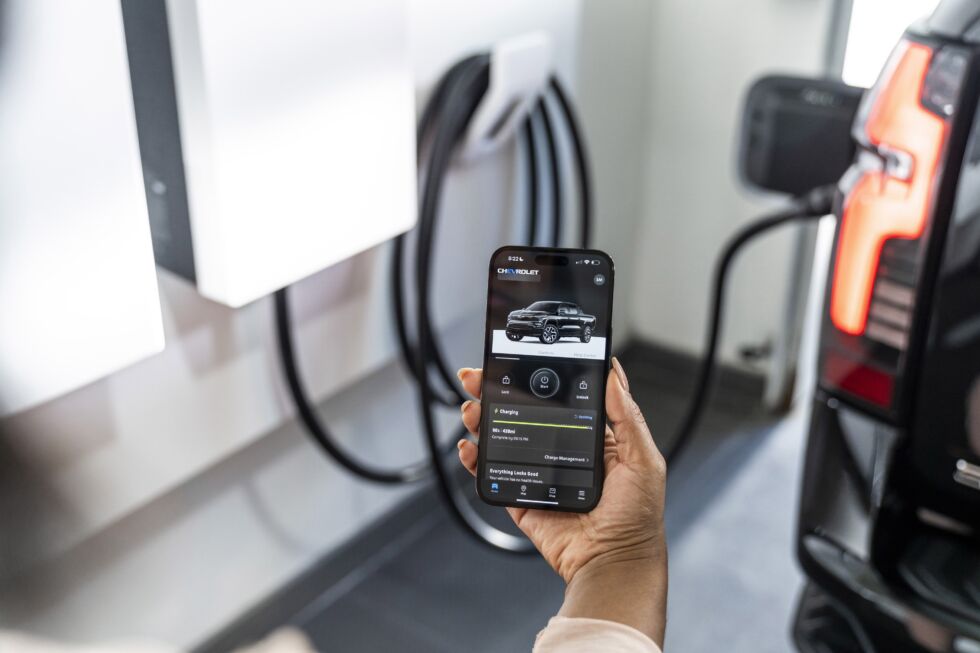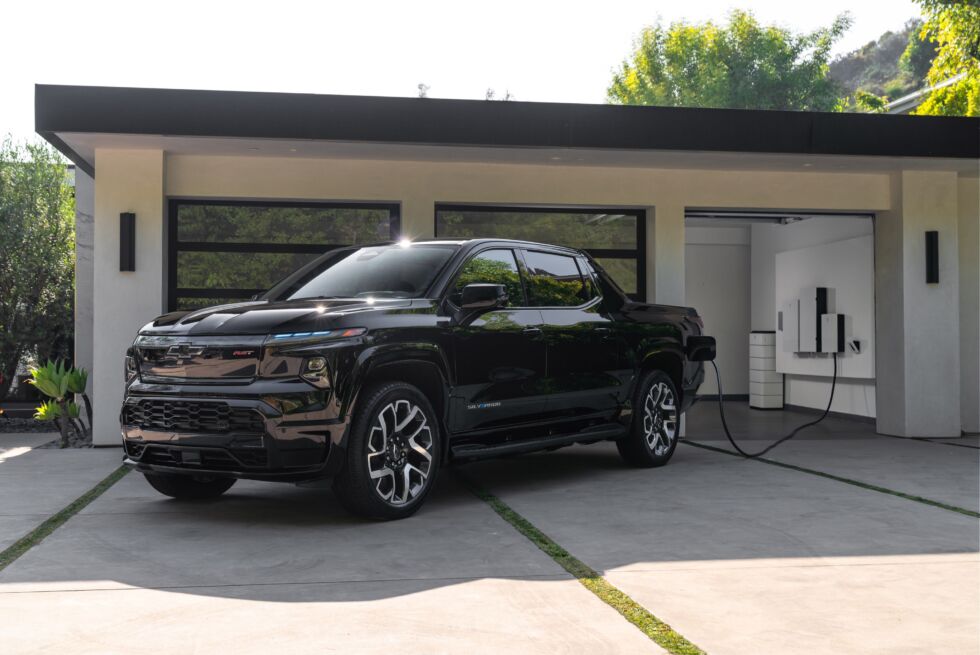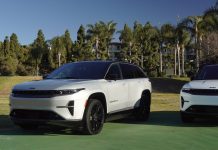GM’s Ultium-based EVs can power your house during an outage.

LOS ANGELES—Let’s face it: The American power grid is a hot mess. The system is outdated and overstressed by amp-sucking appliances, air conditioning units, and extreme weather. Depending on where you live, it’s likely only a matter of time before your home will experience a blackout. GM Energy, a subsidiary of General Motors, is here to help.
At a demonstration in a swanky 10,000-square-foot mansion in Beverly Hills, California, where I counted 51 recessed lights in the great room, the new home products from GM Energy easily kept the electrons flowing, eschewing the grid and drawing power from the 200 kWh battery in a 2024 Chevrolet Silverado RST.
It all starts with the GM Energy PowerShift charger. On an 80 A circuit, the charger can charge your EV at a whopping 19.2 kW, and its bi-directional technology can push electrons from the truck’s battery into an inverter to convert it to the AC power your home requires. The happy little AC current then goes into the Home Hub that distributes the power to the appropriate circuits, and voilà—the lights are on.
But if the power goes out suddenly, how does the process start? GM Energy’s “Dark Start” battery holds just enough juice to get the whole thing running. At the demo, it took about 36 seconds from the main breaker being shut off to the system powering up, flooding the garage full of tech reporters and GM brass with steady, non-flickering lights. Oh, and of course, you can keep track of everything in the My Chevy app.

Currently, the system only works with the Silverado EV RST. The company expects the EV versions of the 2024 Sierra Denali, Cadillac Lyriq, and Chevrolet Blazer and Equinox to come online soon, though some may require a dealership or over-the-air update. GM plans to include bidirectional technology on all its Ultium-based EVs by model-year 2026. As for the Honda Prologue and Acura ZDX EVs that were developed in partnership with GM—no dice. Owners of those cars will not be able to use this technology.Advertisement
One further bugaboo was found on the GM Energy website, which says, in tiny print, that the products are only available in California, Florida, Michigan, New York, and Texas. However, the company says the tech will be available in all 50 states later this year.
How long can it last?
GM Energy engineer Brent Deep has been running the system for two years with no problems. He claims his family has not been trying to conserve power, instead running two air conditioning units, a hot tub, laundry machines, an electric range, an oven, and the myriad other appliances four people in Michigan would use to remain comfortable. In this case, a Silverado RST can power the house for four days.
Deep and his family are slightly heavy in their energy use, however. The US Energy Information Administration says the average house uses 899 kWh of energy every month, or about 30 kWh per day. By that math, the Silverado RST should provide juice for just over six days.
I, however, do not have a family of four. In fact, I’m a bit of an electricity miser, at least during the non-summer months. I live in the high desert of California but still keep the air conditioning at 80 degrees in my two-bedroom home during the hot season, turn off every light except the one I’m using, and if I can eke out another wear of a pair of jeans instead of throwing them in the laundry, I do it. How long could I power my house?
When I looked at my bill for the past 12 months, the least I’ve used was 126 kWh in April of 2024, for which Southern California Edison charged me $53.35. I used the most in July of 2023: 774 kWh for $325.
ARS VIDEO
How The Callisto Protocol’s Gameplay Was Perfected Months Before Release
California has all kinds of peak, off-peak, and super off-peak rates, plus summer rates, winter rates, weekday and weekend rates—there’s probably a rate for when the moon is full and Saturn is in retrograde. So let’s just take the average of the highest and lowest rates for those two months and say I paid $0.45/kWh.
How much would I pay per kWh if I used the truck as a battery? Assuming my local EVGo 350 kW charger works, which is a stretch, I could be charged a rate as low as $0.21/kWh. Of course, that all depends on my monthly plan, but I could theoretically halve my electricity bill.

Plus, at my non-summer rate of consumption, I could keep my house running all month on a single charge, but I’d have to juice up a few times to keep the air conditioning running during the summer months.
Of course, that’s not really a tenable solution. First of all, I’m not letting a $96,000 truck just sit in the garage. So I’d have to drive it at some point, leaving my two cats to suffer in the summer when the house gets over 90 degrees inside. Plus, who wants to sit around waiting to charge to 100 percent? Ain’t nobody got time for that!
If you accidentally use all the power in your truck to keep your house running, GM Energy will soon offer batteries that can store up to 35 kWh of power. These can be used to power your house or vehicle, and the company says the stackable battery system will be available later this year. Also coming online in the near future is compatibility with solar systems so you can have all the power you need, even when the sun hides behind the clouds all day.Advertisement
One percent down, 99 to go
Back at our fancy-pants mansion, the RST started with a 100-percent charge, and after an hour or so, the dashboard said it was down to 99 percent. The truck was pushing 5 kW into the house, but the system can handle up to 9.6 kWh of discharge power. While there didn’t seem to be an HVAC system online for the mild California evening, there were the aforementioned 51 LED lights, a sound system, outdoor lighting, a full kitchen’s worth of appliances, Internet, and likely security cameras and whatever else rich folks have in their house to keep the riff-raff at bay.
You can buy the system as modular pieces, so if you’re only interested in the super-fast level 2 PowerShift charger, you can snag it for $1,699. If you already have the charger at home, the inverter, hub, and Dark Start battery can be had for $5,600. There is no discount for bundling them together.
Later this year, you can purchase the hub, inverter, and storage pack for $11,000 or get the whole shebang, including the charger, for $12,699.
Keep in mind that those prices do not include installation. GM Energy has partnered with Qmerit to provide certified installers, and you may also receive a tax or installation credit with the purchase of your system. GM Energy has a nifty website to help you sort through the complexity.
In my situation, energy independence means a solar system, but for folks who have invested in a GM vehicle on the Ultium platform, this seems like an easy decision.
Remember, however, that the rest of the EV lineup—except for the GMC Sierra Denali EV—doesn’t have batteries as big as the Silverado EV’s. The Lyriq sports a 102 kWh battery, and the Blazer and Equinox have even smaller batteries. It’s always best to conserve during an emergency and hope your local grid isn’t down for too long.




